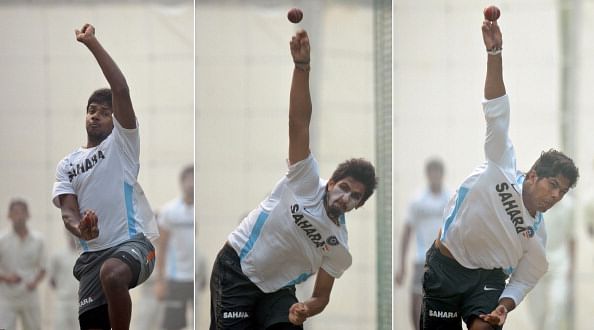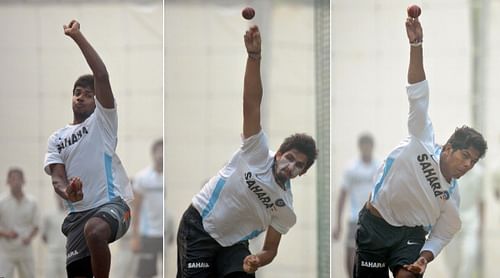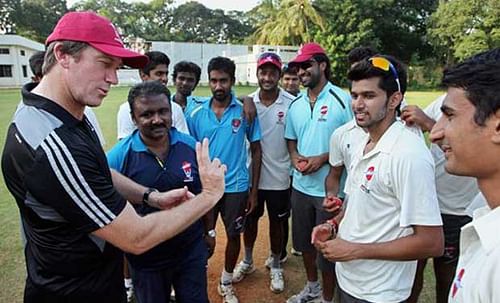
Breeding a Dale Steyn - An Indian fantasy

Aaron, Sharma, Yadav: Indian pace trio
The scarcity of genuine Indian pacers is perhaps one of the most widely debated and analyzed topic in the cricketing world. There have been various theories dominating the round-table gossips and breakfast table conferences, yet none of them present the complete scenario regarding the reasons behind India’s failure to produce world-class fast bowlers who can maintain their pace and accuracy persistently.
It would have been less perplexing had the entire subcontinent suffered from this chronic deficiency of pacers. But what makes it fascinatingly intriguing is the fact that while Pakistan has been consistently giving birth to world class fast bowlers, India and Sri Lanka have failed to do so!
While it is quite another topic – an overwhelmingly bamboozling one, I assure you – as to why Pakistan has had the advantage of breeding pacers whereas their neighbours, even with better facilities, have fallen short of doing so, it is captivating to scrutinize in isolation the reasons behind India’s unceasing deficit in the pace bowlers’ department.
The list of criteria for an authentic pacer is demanding enough. While clocking the 150 kmph mark regularly on the speedometer is a primary necessity, maintaining accuracy without reducing speed remains a priority. Swinging the cherry effortlessly at such breakneck speed is another requirement, which when coupled with occasional bouncers adds lethality to the attack. In simple words, an ideal pacer is nothing short of a combination of brutal aggression and fearless belligerence haunting the batsmen even in their nightmares.
Apart from Mohammed Nissar and Amar Singh, India has never witnessed such a bowler in its rich cricketing history. The amazingly successful Kapil Dev had been merely a medium pacer while the likes of Javagal Srinath, Zaheer Khan, Ajit Agarkar, Irfan Pathan and Ishant Sharma have all been reduced to medium pacers in the later stages of their careers.
Adhering to the pace which one has during the initial stages of one’s career and maintaining that velocity till the very end requires Herculean efforts, both physically and mentally. The level of strength and vigour in the muscles and the amount of physical fitness essential for a genuine pacer are invariably absent in Indian bowlers.
A broad-chested, muscular physique with impeccable athleticism remains the precise dream of every talented Indian bowler. However, with the dwindling economic status of the country, the dream now appears more far-fetched than ever.
The careers of Zaheer Khan and Irfan Pathan are ample testament to the consequences of pushing oneself too hard in order to sustain raw pace while specializing on swinging the ball both ways, and getting injured or pulling a muscle in the process. Such negative impacts on health ultimately compelled them to reduce their pace and concentrate more on swing and accuracy.
The case of Varun Aaron, who struck gold with incredible pace at the beginning of his career but has been sidelined with injuries in the last two seasons, recognizes the unquestionable requirement for greater fitness in the Indian camp.

Glenn McGrath at the MRF pace academy
Even for those who have, somehow, braved the odds and survived the battle of the fittest, the domestic circuit offers the non-negotiable barricade of flat pitches, traversing which is a task more intimidating than hitting a boundary off a Lasith Malinga yorker.
Exposed to dead pitches which offer minimal swing or biased turning tracks which assist spinners, the pacers have little choice but to toil hard, frequently without success. Flat tracks not only dilute the reservoir of talent, but also discourage youngsters to take up the once-lucrative job of pace bowling. The blunt tracks have reduced the art of embedding fear in the souls of the batsmen to merely a disillusioning job of containing them.
More often than not, the lack of wind implies nothing can be done by a seamer except trying to extract bounce, if any, from the surface. With the spinners whirling in a pool of success, a pacer is bound to feel powerless and dejected.
Running in hard to deliver the cherry at a mind-boggling pace only to see it rush towards the fine leg, courtesy a reluctant flick by the batsman, is sure to hammer the confidence of a fast bowler who would then wonder if he wouldn’t have been better off doing something else.
The ever-increasing disparity of accomplishments between the spinners and the fast bowlers on the domestic circuit is certain to create disenchantment towards fast bowling among youngsters who would prefer the easier route to success by twirling the ball at a less-than-decent pace.
It is, of course, easy to question the role of the MRF Pace Academy where the legendary Dennis Lillee works with youngsters to hone their pace bowling skills. Set up with the novel vision of producing fast bowlers who would stamp their authority in international cricket, the academy has manufactured nothing of substance till now.
The step-motherly attitude towards fast bowling continues to be ubiquitous in the country and without any change in such an approach, the odds of an Indian pacer breaking into the ICC Top 10 rankings in the next five years appear completely implausible.
While the Indian batsmen are bound the face the heat when they tour South Africa or Australia in the near future, efforts to nurture the very reason of their apprehension on foreign lands seem to be completely escaping the minds of the authorities.
Supporting the fast bowlers and building them up, both physically and psychologically, will be a daunting task, but is achievable nevertheless. With the right kind of disposition and sensible management of resources, technology and infrastructure, India can well make its own mark in the world of fast bowling.
Nothing of that sort, though, is going to happen in the next five years.